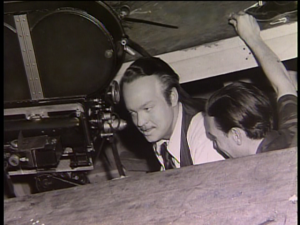I will bring you 5 Best Backstage Photographies every week. No matter what genre, no matter what era, pure fun and excitement!
#1 – Orson Welles checking the frame before his performance as Citizen Kane (1941)

Lawrence G. Paull was born in 1938 in USA. Paull is best known for his work on Ridley Scott’s sci-fi film Blade Runner (1982). This movie is considered as one of production design breaking points and is the project Paull was nominated for Academy Award for production design. In 1982 Oscar went to creators of Ghandi, but Paull won BAFTA together with futurist Syd Mead and VFX inventor Douglas Trumbull. Three years later, Paull was nominated for BAFTA again for his another famous movie – Back to the Future (1985). As majority of production designers, Paull has architecture background, he graduated from architecture faculty of University of Arizona. Shortly after, he discovered that conservative world of architecture is not for him and after seeing Dr. Zhivago (1965), movie that was being set in deep frozen Russia, but being shot in hot spain, movie significant for its art direction, he decided films are his future. in 60s Paull worked as draftsman on numerous productions before he actually started to work as set designer and art director. Later in 70s he made his first movie as production designer called Little Fauss and Big Halsey (1970). Paull was also teaching production design program at Los Angeles film school since 1999 for a short period of time and is a professor at the Chapman University’s Dodge College of Film and Media Arts.
I guess I dont have to introduce this iconic film released in 1985 under direction of Robert Zemeckis, designed by one of the best production designers ever – Lawrence G. Paull. One of the most significant movie vehicle was designed for this series: Back to the Future’s DeLorean.
Period movies are always challenge for production designers as much as fun. When you are about to connect 50s, 80s and near future – it sounds like a lot of fun.
Motive of time, clock and time traveling goes through all the story of Back to the Future. Obviously, its the main plot, but even in the brilliant opening sequence, that was created like one continuous storytelling shot, you can see importance of time for dr. Emmett Brown and get introduced to the story just with props and set dressing of Brown’s lab.
Besides all the gadgets dr. Brown has in his house in 80s or all the useless inventions in 50s, the thing that interests us the most is obviously the DeLorean time machine. Production designer Larry Paull and executive producer Steven Spielberg hired veteran of movie design, former Disney animator, concept artist Ron Cobb, man who stands behind designs for movies such as Alien, Star Wars, Indiana Jones and others.
Since I lately work also as freelance storyboard artist for short movies, I felt need to expand my knowledge in this area. I found out, that there are not many books about storyboarding or storytelling through pictures. Except brilliant book, what I would like to review in future, written by Marcos Mateu-Mestre – Framed Ink (Design Studio Press) there is also The Art of Storyboard by John Hart and some others. I will review today book by well known storyboard artist Giuseppe Cristiano – The Storyboard Artist: A Guide to Freelancing in Film, TV, and Advertising. Book was published by Michael Wiese Productions in 2011. Giuseppe Cristiano is artist who is in the industry for more than 20 years. He worked on projects for film, game or comics industry. He is originally from Italy, nowadays living in L.A. and giving lectures about storyboarding and storytelling around the world. This book was created mainly as his handbook for the lectures and also as insider look into the industry, because there is a lot of practical examples and stories “from life”.
Technically, the book is not at good level. I must admit, that cover design of book is one of criteria what tells me to buy or not to buy it. This particular book has nice cover with decent graphic solution and nice illustration. Graphically and typographically the book is decent. Its quite clearly divided, the problem is, that pictures are not numbered. Therefore, sometimes you don’t know to what image author refers in the text. The book is black and white without any colored examples, what is quite shame, because author also writes about using color in storyboarding. Paper quality is low, but because of that all, so is the price. The biggest problems in the book are the mistakes in text and missing words. There are paragraphs, where author wanted to mention reference movies or names and they are just missing, so the reader is also missing the point and it happens quite often during reading. Next time better “doublecheck” everything.
Production Designer
pretentious about pop culture
A reflective journal for all my creative projects
Blog of Jiri Karasek - creative Production Designer and Art Director based in Prague, Czech Republic.